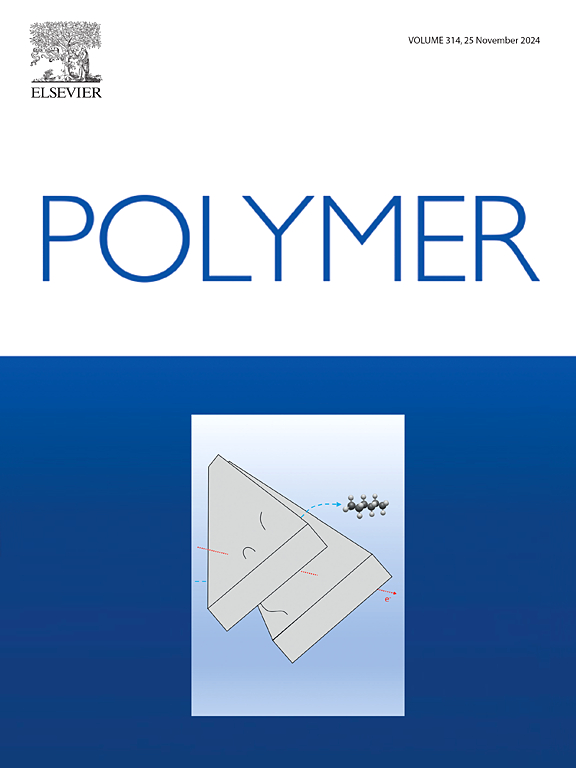Molecularly engineered Polyarylene ether nitrile copolymers integrating high thermal resistance with ultralow dielectric loss for advanced electronic applications
IF 4.1
2区 化学
Q2 POLYMER SCIENCE
引用次数: 0
Abstract
The development of polymer materials combining exceptional heat resistance with ultralow dielectric characteristics remains critical for advancing high-frequency communication systems and miniaturized high-temperature electronic devices. This study introduces an innovative array of polyarylene ether nitrile (PEN) statistical copolymers that were synthesized by nucleophilic substitution polymerization, strategically incorporating biphenol AP (BPAP) for dielectric optimization, fluorene-based bisphenol (BPF) for thermal stability enhancement, and 2,6-dichlorobenzonitrile (DCBN) as the activating monomer. Systematic characterization reveals that the optimized PEN-50 copolymer exhibits superior comprehensive performance, achieving a glass transition temperature (Tg) of 237 °C while maintaining excellent dielectric properties (ε = 3.3, tanδ = 0.008, @1 MHz). The semi-crystalline film exhibits exceptional tensile performance, attaining 66 MPa tensile strength and 2.03 GPa elastic modulus. These outstanding thermomechanical properties combined with ultralow dielectric losses position the PEN-50 copolymer as a promising candidate for advanced applications in next-generation high-frequency communication devices, aerospace electronics, and high-density integrated circuits requiring simultaneous high-temperature stability and signal integrity preservation.


分子工程聚芳醚腈共聚物集成高热阻和超低介电损耗先进的电子应用
结合优异的耐热性和超低介电特性的聚合物材料的发展对于推进高频通信系统和小型化高温电子设备仍然至关重要。本研究介绍了一种创新的聚芳醚腈(PEN)统计共聚物阵列,该共聚物通过亲核取代聚合合成,战略性地加入双酚AP (BPAP)来优化介电,芴基双酚(BPF)来增强热稳定性,2,6-二氯苯腈(DCBN)作为活化单体。系统表征表明,优化后的PEN-50共聚物具有优异的综合性能,实现了237℃的玻璃化转变温度(Tg),同时保持了优异的介电性能(ε=3.3, tanδ=0.008, @1 MHz)。该半晶膜具有优异的拉伸性能,拉伸强度达到66 MPa,弹性模量达到2.03 GPa。这些优异的热机械性能加上超低介电损耗使PEN-50共聚物成为下一代高频通信设备、航空航天电子和高密度集成电路中需要同时保持高温稳定性和信号完整性的先进应用的有希望的候选者。
本文章由计算机程序翻译,如有差异,请以英文原文为准。
求助全文
约1分钟内获得全文
求助全文
来源期刊

Polymer
化学-高分子科学
CiteScore
7.90
自引率
8.70%
发文量
959
审稿时长
32 days
期刊介绍:
Polymer is an interdisciplinary journal dedicated to publishing innovative and significant advances in Polymer Physics, Chemistry and Technology. We welcome submissions on polymer hybrids, nanocomposites, characterisation and self-assembly. Polymer also publishes work on the technological application of polymers in energy and optoelectronics.
The main scope is covered but not limited to the following core areas:
Polymer Materials
Nanocomposites and hybrid nanomaterials
Polymer blends, films, fibres, networks and porous materials
Physical Characterization
Characterisation, modelling and simulation* of molecular and materials properties in bulk, solution, and thin films
Polymer Engineering
Advanced multiscale processing methods
Polymer Synthesis, Modification and Self-assembly
Including designer polymer architectures, mechanisms and kinetics, and supramolecular polymerization
Technological Applications
Polymers for energy generation and storage
Polymer membranes for separation technology
Polymers for opto- and microelectronics.
 求助内容:
求助内容: 应助结果提醒方式:
应助结果提醒方式:


